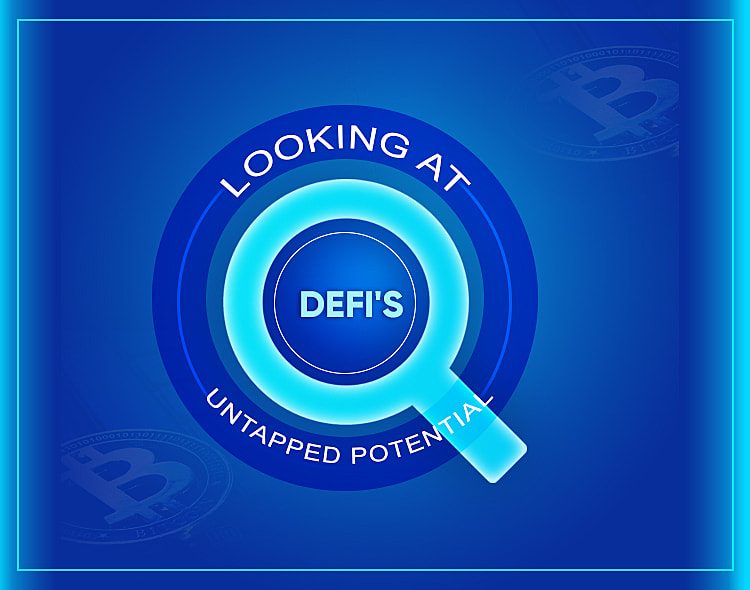DeFi or Decentralized finance is the most innovative crypto domain which has taken its wing in the last couple of years. DeFi has intelligently used the smart contract sphere to embrace a network of interconnected layers for decentralized financial services. The ups and downs are a part and parcel of every cycle. DeFi protocols for the next generation have a plethora of options. Let’s limelight such opportunities- the untapped potential of the DeFi domain.
CeDeFi
Assets formulate the most vindictive part in every sphere, so how could DeFi escape from being an exception towards it? The stablecoins have driven the entire DeFi market by overcoming the cryptocurrency market’s volatility. Its innovation made non-volatile account units important to lend, borrow, and forecast interest payments. Such protocols use stablecoins as an asset since they offer high trust and reduce volatility.
More potential in synthetic and real-world assets must be taken advantage of (RWAs)
Some blockchains lack such protocols that do not fit into the DeFi ecosystem, despite having unique protocols that build synthetics and RWAs. Without owning the underlying asset, investors can profit from synthetic assets with ease. Because to their product structure, they enable investors to trade in and invest in a variety of crypto commodity classes that would otherwise be inaccessible. Such synthetic assets are also used by DeFi protocols to scale them up in terms of availability and liquidity. A stable DeFi-TradFi bridge is Required. Both institutional and retail blockchain investors are drawn to RWA’s protocols.
Read latest article: What Are Capital Markets?
Powerful Engines For The DeFi Landscape: DEX And Lending
Almost 50% of the total DeFi deposits are captured by the basic DeFi layer, which permits all assets to be utilised as loan collateral and permits users to pledge their assets. Few protocols can draw TVL, which in turn guarantees a flow of liquidity that improves the cryptocurrency lending landscape. In the exchange protocols, automated Market Makers for such volatile and stable assets are distinguished. Slippage is decreased by stable AMMs, increasing the efficiency of stablecoin trade. The deep liquidity of AMMs and the minimal slippage of robust swap protocols are essential for high-layer asset circulation and optionality.
Untapped Potential In Derivatives
Derivatives, indexing, and options are soulmates of the advanced DeFi landscape. These DeFi products are eminent, but they don’t possess the advanced features of the blockchain. More options and derivatives are required. Solana in the options market has proved itself that Ethereum could take a large market share with the right measured protocols. New derivatives and Options are in need. Options are normally used for basic financial strategies like hedging and could be attractive in entire volatile markets. On the other hand, the option protocols are eminent for the institutions, which makes them a key tool for the blockchain domain. Retail users are unfamiliar with the Greek, money, or American options, so they rarely use options. Blockchains need option vault protocols to offer automated option strategies to delegate to their users.
Yield Aggregators
The following parameter is the Aggregation Layer. Capital is gathered and distributed to other protocols through supply-side protocols. The ecosystem participants that constantly compete with the top blockchain market share leaders and ultimately triumph in the “war” with them may benefit from new protocols.
Payments: The Opportunity For DeFi To Drive Global Economic Growth
The aggregation layer, which prioritises payment procedures and affects millions of people in underbanked nations who lack either a bank account or a credit card, is also in the spotlight. On the other hand, blockchains can quickly offer millions of people a safe, decentralised, and non-discriminatory payment service. Unrestricted, decentralised blockchain-based payment services. In order for e-commerce to be supported by crypto assets, a reliable crypto payment gateway is required to reach the broadest possible audience. Just a select few stablecoins can provide the ideal foundation upon which the ecosystem can compete with fiat currencies.
Security, compliance, and insurance on the Road to Trustless DeFi Infrastructure
Blockchain secures across all layers of DeFi. To avoid systemic risks which spread throughout the chain, as with well-known projects. To expand DeFi now, investors and users must feel in safe hands, which requires risk-aware protocols like -Risk management, compliance, and insurance. A few blockchains lack contract audit protocols. Blockchains must prioritize insurance and stress testing so that they can differentiate themselves as secure, trustworthy technology. Based on market share, there’s room to develop a few leading protocols. Such projects shall help the ecosystem navigate those uncertain times so that they can build a new DeFi paradigm.
Conclusion
A DeFi landscape’s assets and DeFi Basic layers can also be strong. Great liquidity in the AMM, stable swap, lending, and a stablecoin are required to scale the upper layers, wherein the rest of the gap. Derivatives, prediction markets, indexing, and payment solutions should be on the top list. Although security, compliance, and insurance protocols are indeed important for blockchain, now the time has arrived to help innovative protocols to achieve their goals and for the promotion of mass crypto adoption.
Read latest article: Benefits Of BaaS For Fintech And Non-fintech Companies
[To share your insights with us, please write to sghosh@martechseries.com]
